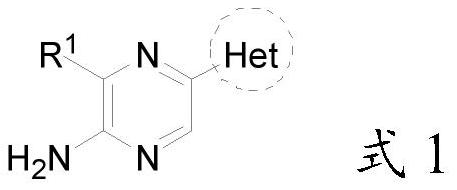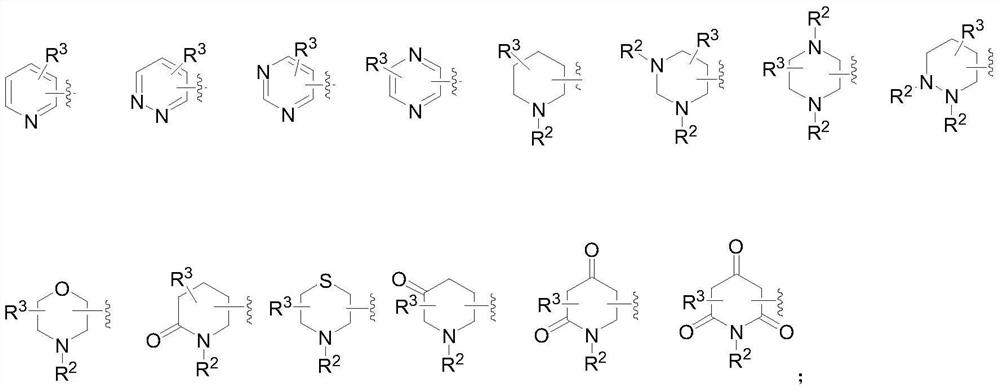2-amino-5-heterocyclyl-substituted pyrazine derivative and application thereof
A technology of pyrazine derivatives and heterocyclic groups, applied in the field of pyrazine derivatives, can solve the problems of expensive drugs, toxic side effects and the like
- Summary
- Abstract
- Description
- Claims
- Application Information
AI Technical Summary
Problems solved by technology
Method used
Image
Examples
Embodiment 1
[0108] Embodiment 1: The synthetic route of compound 2 is as follows:
[0109]
[0110] Step 1): Take the sodium salt of diaminopyrazine as raw material, mix and heat 192g of phosphorus oxychloride and 1.8g of sulfuric acid to 60-70°C, then slowly add 120g of sodium salt of diaminopyrazine to it, and then dissolve the The mixture was heated to 100-150°C for 2h, then cooled to 30-40°C, neutralized with 30% sodium hydroxide solution, extracted and rectified to obtain 100g of 2-amino-3-chloropyrazine, yield 87%;
[0111] Step 2): Make m-bromopyridine into Grignard reagent, add trimethyl borate dropwise thereto, control the molar ratio of trimethyl borate to m-bromopyridine to be (1.1-1.2):1, cool during the reaction, Control the reaction temperature at 10-20°C, and continue the cooling reaction for 30 minutes after the dropwise addition to obtain meta-substituted pyridine boronic acid compounds;
[0112] Step 3): Dissolve the 2-amino-3-chloropyrazine in step 1) in tetrahydro...
Embodiment 2
[0113] Embodiment 2: The synthetic route of compound 20 is as follows:
[0114]
[0115] Step 1): using diaminopyrazine as a raw material, dissolve it in tetrahydrofuran to obtain a solution, add aluminum trichloride catalyst and n-propane chloride to it under nitrogen protection, and control the amount of aluminum trichloride to be that of diaminopyrazine. 1.5%, the molar ratio of n-chlorinated propane to diaminopyrazine is (1.2~1.5):1, react under the condition of 80~90°C to get 2-amino-3-n-propylpyrazine, the yield is 88 %;
[0116]Step 2): Make m-bromopyridine into Grignard reagent, add trimethyl borate dropwise thereto, control the molar ratio of trimethyl borate to m-bromopyridine to be (1.1-1.2):1, cool during the reaction, Control the reaction temperature at 10-20°C, and continue the cooling reaction for 30 minutes after the dropwise addition to obtain meta-substituted pyridine boronic acid compounds;
[0117] Step 3): Dissolve the 2-amino-3-n-propylpyrazine in st...
Embodiment 3
[0118] Embodiment 3: The synthetic route of compound 82 is as follows:
[0119]
[0120] Step 1): using diaminopyrazine as a raw material, dissolve it in tetrahydrofuran to obtain a solution, add aluminum trichloride catalyst and cyclohexane bromide to it under nitrogen protection, and control the amount of aluminum trichloride to be diaminopyrazine The molar ratio of bromocyclohexane to diaminopyrazine is (1.2~1.5):1, react under the condition of 80~90℃ to get 2-amino-3-cyclohexylpyrazine, the yield is 79%;
[0121] Step 2): Make m-bromopyridine into Grignard reagent, add trimethyl borate dropwise thereto, control the molar ratio of trimethyl borate to m-bromopyridine to be (1.1-1.2):1, cool during the reaction, Control the reaction temperature at 10-20°C, and continue the cooling reaction for 30 minutes after the dropwise addition to obtain meta-substituted pyridine boronic acid compounds;
[0122] Step 3): Dissolve the 2-amino-3-cyclohexylpyrazine in step 1) in tetrahy...
PUM
 Login to View More
Login to View More Abstract
Description
Claims
Application Information
 Login to View More
Login to View More - R&D
- Intellectual Property
- Life Sciences
- Materials
- Tech Scout
- Unparalleled Data Quality
- Higher Quality Content
- 60% Fewer Hallucinations
Browse by: Latest US Patents, China's latest patents, Technical Efficacy Thesaurus, Application Domain, Technology Topic, Popular Technical Reports.
© 2025 PatSnap. All rights reserved.Legal|Privacy policy|Modern Slavery Act Transparency Statement|Sitemap|About US| Contact US: help@patsnap.com



